#basidiomycete yeasts
Text

A Circle of Spores Druid commission I’m very proud of! I’ve never done a kobold before so that took a lot of experimentation, which was worth it to get to shove ~20 species of mushrooms in. (They are not to scale or growing on the right substrates) species with an ‘x’ are toxic and species with a ‘☑️’ are edible.
I don’t do research on basidiomycetes (most mushrooms) except yeasts, but I do appreciate them from afar. I’m an ascomycete person.
#circle of spores#druid art#dnd character art#dnd commission#kobold#mycology in fiction#comission#open art commissions#fungi#basidiomycota#fungi art#character design#artists on tumblr#illustration#art#dnd art#dnd
68 notes
·
View notes
Text
Mushroom-1:Various faces of mushrooms: important creatures for the earth

Lignin (wiki):skeletal component of wood (later)
Mushrooms and molds are almost identical creatures, neither plants nor animals. Mushrooms are the ones that open the umbrella, and molds are the ones that are not made. About mushrooms from wiki:
@@@@@@@@@@@@@@@
Mushrooms (mushrooms, fungi, buds, mushrooms) are a common name for a relatively large (often protruding) fruiting body or basidiomycete itself among specific fungi (Fungi). Also, the word mushroom is often treated as a general term for specific fungi, but it is originally a structure as described above, not a classification of fungi. Fungi that do not produce fruiting bodies are molds. It is clearly different from plants.
There is no clear standard for "large size" here, but mushrooms are often called mushrooms that are large enough to be seen with the naked eye. Some species are toxic, although they are also used for food and psychological effects. Etymologically, it can be analyzed as "tree + + child"(inJapanese). Many fungi with fruiting bodies of visible size belong to the basidiomycota Basidiomycota or the Ascomycota ascomycota.
In Japan, about 300 species are edible, of which more than a dozen are artificially cultivated with mushrooms. It is said that there are about 2,500 known species and about two to three times as many unknown species in Japan, of which about 200 are well-known poisonous mushrooms, and about 20 are highly addicted or deadly poisonous.
@@@@@@@@@@@@@
Generally, I think it can be defined like this. So how do molds and mushrooms grow? From wiki again:
@@@@@@@@@@@@@
The body (entity) of mushrooms is included in a group of organisms called fungi together with mold. It is a tubular cell line called mycelium, which grows by decomposing and absorbing organic matter with enzymes secreted from the body, producing spores and repeating reproduction.
In the "Encyclopedia of Fungi" of the Japanese Society of Fungi, it is explained that fruiting bodies or basidium fruits are so-called mushrooms, hyphal tissue structures that make sexual reproduction organs, and do not refer to classification groups such as fungi.
In other words, strictly speaking, mushrooms are larger, umbrella-shaped ones. However, it is inaccurate, but it can also refer to the species of the organism that makes it. In other words, by definition, all fruiting bodies are mushrooms, or all organisms that make them are mushrooms. In the latter case, for example, minute punctate objects that are stuck or buried on the surface of dead branches are also regarded as mushrooms. It means that the organisms that are mushrooms look like molds or are yeast-like. There is an example in which the Japanese name is also called "mold" for those having such point-shaped fruiting bodies.
@@@@@@@@@@@@@@

Mushroom life cycle (wiki)
(To be continued)
#mushroom#mold#lignin#fungi#edible#poisonous mushrooms#umbrella-shaped#Mushroom life cycle#rei morishita
2 notes
·
View notes
Text
Does any of this sound like the (dubious) human social/cultural constructs called “gender” to you?
Subtitle: How about you read about mating types in depth instead of passing around the same clickbait headline misinfo
Subtitle 2: remember at all times that what is true of sex in other species is not necessarily true of another, let alone comparing Homo sapiens to fungi (different kingdom)
Tetrapolar fungal mating types: sexes by the thousands
Erika Kothe
FEMS microbiology reviews 18 (1), 65-87, 1996
In order to achieve genetic rearrangement in a sexual cycle, eukaryotes go through the processes of meiosis and mating. Different mating types assure that mating is only possible between two genetically diverse individuals. Basidiomycetous fungi display thousands of different mating types that are determined by two genetically unlinked loci. One locus is multiallelic and contains genes for homeodomain transcription factors which are able to form heterodimers. The activation of target genes is dependent on heterodimers formed from the monomeric transcription factor proteins originating from different alleles of this genetic locus. The interactions between the two monomeric transcription factors and the activation of target genes by the heterodimeric proteins make this regulatory system both complex and interesting. The second locus contains a pheromone receptor system: the pheromone receptor is similar to the G protein-linked serpentine receptors in Saccharomyces cerevisiae that activate the pheromone response via a phosphorylation signal transduction cascade in S. cerevisiae. This pheromone perception is a trigger of sexual development and not, as with yeast, itself under control of mating type genes. Rather it directly senses diversity at the mating type loci. Whereas heterobasidiomycetes display a bi-allelic structure for this locus with recognition between one receptor and the opposite pheromone, homobasidiomycetes contain multiple specificities for pheromone receptors and pheromones.
—
Fungal sex: the Basidiomycota
Marco A Coelho, Guus Bakkeren, Sheng Sun, Michael E Hood, Tatiana Giraud
The fungal kingdom, 147-175, 2017
In the phylum Basidiomycota, a wide variety of lifestyles are represented. These range from well‐known and conspicuous wood‐decaying mushrooms, plant growth‐promoting and mutualistic mycorrhizae, and crop‐destroying smut and rust fungi, to yeast‐like human pathogens. Lifestyle differences have consequences for the mating and breeding systems of these fungi (see “Glossary,” below, for definitions of specialist terms used in this article), which are reflected in the genetic evolution of mating‐type determination. For over a century fungi have been recognized as having diverse breeding systems, from homothallism (i.e., universal compatibility among gametes, including among clonemates) to heterothallism (i.e., mating among haploid gametes carrying different mating‐type alleles). The study of breeding systems, for example, led to the discovery of the astounding variability in mating‐type alleles among mushrooms, with thousands of different mating types in some species (1), and to the realization that in many fungal pathogens the process of sexual reproduction is closely linked to infection and pathogenicity (2) (Fig. 1). The importance of basidiomycete fungi and their great research tractability, from ecology to genomics, have brought major insights into the diversification of genetic mechanisms used to achieve sexual reproduction.
—
Mating-Type Locus of Cryptococcus neoformans: a Step in the Evolution of Sex Chromosomes
Klaus B Lengeler, Deborah S Fox, James A Fraser, Andria Allen, Keri Forrester, Fred S Dietrich, Joseph Heitman
Eukaryotic Cell 1 (5), 704-718, 2002
The sexual development and virulence of the fungal pathogen Cryptococcus neoformans is controlled by a bipolar mating system determined by a single locus that exists in two alleles, α and a. The α and a mating-type alleles from two divergent varieties were cloned and sequenced. The C. neoformans mating-type locus is unique, spans >100 kb, and contains more than 20 genes. MAT-encoded products include homologs of regulators of sexual development in other fungi, pheromone and pheromone receptors, divergent components of a MAP kinase cascade, and other proteins with no obvious function in mating. The α and a alleles of the mating-type locus have extensively rearranged during evolution and strain divergence but are stable during genetic crosses and in the population. The C. neoformans mating-type locus is strikingly different from the other known fungal mating-type loci, sharing features with the self-incompatibility systems and sex chromosomes of algae, plants, and animals. Our study establishes a new paradigm for mating-type loci in fungi with implications for the evolution of cell identity and self/nonself recognition.
0 notes
Text
Transcriptomics elucidates metabolic regulation and functional promoters in the basidiomycete red yeast Xanthophyllomyces dendrorhous CBS 6938
Genomics has become the primary way to explore microbial diversity, because genetic tools are currently difficult to develop in non-model organisms. Here, we demonstrate that -omics can be leveraged to accelerate genetic tool development for the basidiomycete yeast Xanthophyllomyces dendrorhous CBS 6938, the sole biotechnologically relevant organism in the Tremellomycete family. First, we sequence the genome. Then, we perform transcriptomics under a variety of conditions, focusing on light and oxidative stress. This data not only reveals novel photobiology and metabolic regulation, it also allows derivation of constitutive and regulated gene expression parts. Our analysis of X. dendrorhous photobiology shows for the first time that a complex system of white-collar and cryptochrome homologs mediate response to ultraviolet light (UV). Our analysis of metabolic regulation shows that UV activates DNA repair, aromatic amino acid and carotenoid biosynthesis and represses central carbon metabolism and the fungal-like apoptotic pathway. Thus, X. dendrorhous shows a dynamic response toward biosynthetic pathways for light-absorbing compounds and survival and away from energy production. We then define a modular cloning system, including antibiotic selections, integration sites, and reporter genes, and use the transcriptomics to derive strong constitutive and regulated promoters. Notably, we discover a novel promoter from a hypothetical gene that has 9-fold activation upon UV exposure. Thus, -omics-to-parts workflows can simultaneously provide useful genomic data and advance genetic tools for non-model microbes, particularly those without a closely related model organism. This approach will be broadly useful in current efforts to engineer diverse microbes. http://dlvr.it/St3Twv
0 notes
Text
TYPES OF FUNGUS
It is estimated that there are around three million species of fungi however there is only around 144,00 known species all with different shapes, sizes and colours. Some of these are:
-Cordycepts
-Penny Bun
-Agaricus
-Agaricus bisporus
-Fly agaric
-Oyster Mushroom
-Flammulina fliformis
-Candida
-Death cap
-Shiitake Mushroom
-Lacquered bracket
-Sac fungi
-Chanterelle
-True morels
-Penicillium
-Basidiomycetes
-Amanita
-Aspergillus
-Brewer’s Yeast
-Zygomycota
-Pleurotus
-Lion’s mane
-Ganoderma
-King trumpet mushroom
-Candida albicans
-Snow fungus
-Parasol mushroom
-Chytrids
-Turkey tail
-Mucor
-Boletus
-Honey fungus
-Chaga mushroom
-Tuber
-Satan’s bolete
-Corn smut
-White beech mushroom
-Caterpillar fungus
-Matsutake
-Cryptococcus neoformans
-Black mold
-Lactarius deliciosus
-Ergot
-Liberty cap
-Wood ear
-Hen-of-the-wood
-Lingzhi
-Psilocybe
-Straw Mushroom
-Rhizopus
As there are so many different types of fungi I am going to choose a handful of them that stand out to me and research them in depth. so far the ones that stand out to me the most are Oyster Mushrooms, Lacquered Bracket, Chanterelle, Turkey Tail, Agaricus and Psilocybe.
0 notes
Text
Líquenes: casa de muchos
No es uno ¡son dos! ¿tal vez tres? ¿más?

Los líquenes son en esencia organismos compuestos, creaturas simbióticas. Tradicionalmente, se les definía como integrados por un micobionte (un hongo) y un fotobionte (algún organismo que haga fotosíntesis: como las algas verdes o cianobacterias). Sin embargo, estudios realizados durante la última década han cambiado la forma en que vemos los líquenes, y dejado en claro que se tratan de algo más complejo. Un pequeño y auto-contenido ecosistema.
Por ejemplo, en un estudio realizado en 2016, identificaron la presencia extendida de levaduras (otro hongo! pero unicelular) en un par de líquenes de Norteamérica. Estas levaduras, en el caso de las dos especies de liquen (Bryoria spp.) fueron la diferencia clave, que explicaba la hasta entonces inexplicada coloración distinta entre ambas especies. Es decir, un tercer, y hasta entonces anónimo integrante, estaba afectando directamente las características físicas del liquen.
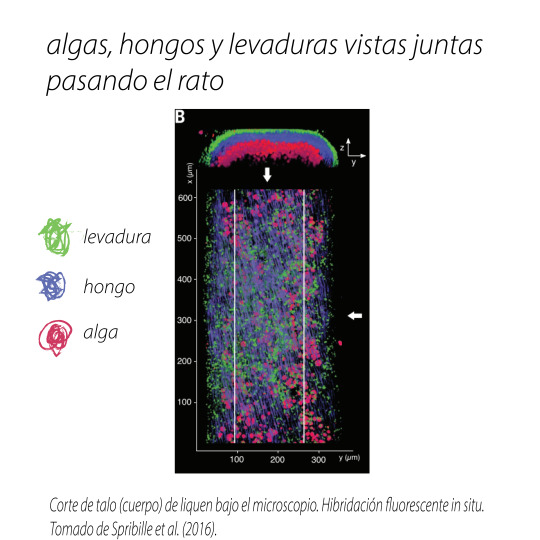
Ese es solo un ejemplo. Además de levaduras, hay muchos otros microorganismos asociados a los líquenes: se han encontrado bacterias, protistas e incluso virus en ellos. ¿Qué tanto son parte de esta simbiosis?
Algunas bacterias sirven en este pequeño ecosistema como fijadoras de nitrógeno, ciertas bacterias se encuentran solo en la superficie o aprovechan la humedad y sombra debajo del talo. La estructura, forma y función de los líquenes podría estar dictada por estos discretos participantes ¡pero aún no lo sabemos!
A continuación algunos líquenes vistos en Oaxaca:


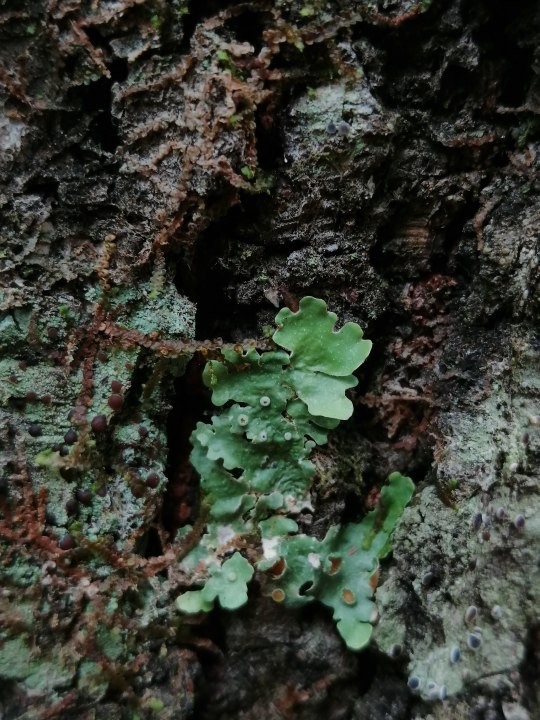
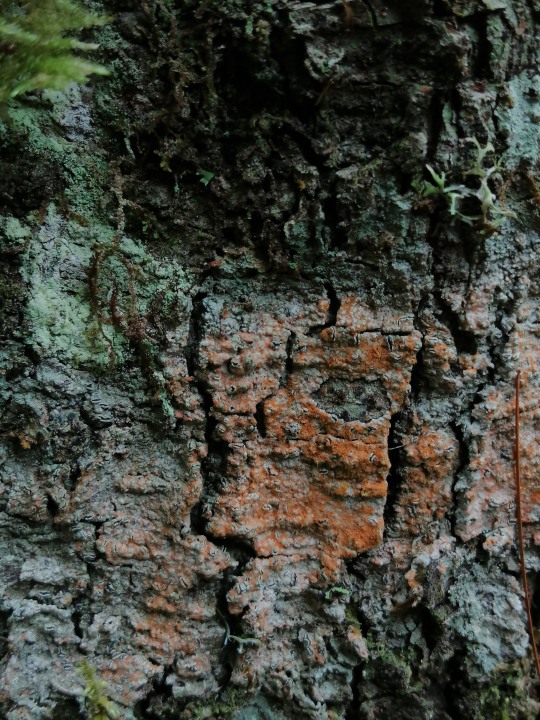

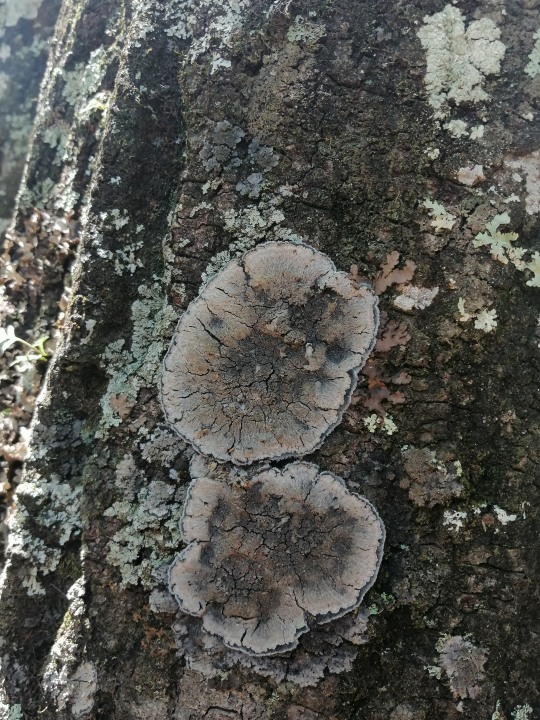
Literatura consultada
Spribille, T., Tuovinen, V., Resl, P., Vanderpool, D., Wolinski, H., Aime, M. C., ... & McCutcheon, J. P. (2016). Basidiomycete yeasts in the cortex of ascomycete macrolichens. Science, 353(6298), 488-492.
Morillas, L.; Roales, J.; Cruz, C.; Munzi, S. Lichen as Multipartner Symbiotic Relationships. Encyclopedia 2022, 2, 1421–1431. https://doi.org/ 10.3390/encyclopedia2030096
Nash, T. H. (Ed.). (2008). Lichen biology. Cambridge University Press
1 note
·
View note
Text
i think it would be kind of funny to make on of those “articles/books i’ve read/videos i’ve watched/etc recently” posts bc it would just be all like 10+ page scientific research papers or paper reviews or hour long presentations on disease ecology instead of the typical like political oped, media analysis, poetry, short story compilation that i usually see a lot of
#and i really don't mean this in like a 'stem vs humanities' way i swear i know that is an artificial and ultimately harmful divide#it's just so amusing to me to imagine one of those posts but it's just chalk full of the driest titles imaginable like#'ionizing radiation changes the electrical properties of melanin and enhances the growth of fungi' with ten author names listed after it#(this is an actual research paper i'm reading right now btw)#or 'basidiomycete yeasts in the cortex of ascomycete macrolichen'#but in all honesty i've read some pretty cool research papers this year and if anyones interested i have all the pdfs and could do this#easily#c.hex posting
3 notes
·
View notes
Text
What is Fungi? Definition, Classification, Examples
What is Fungi? Definition, Classification, Examples
In this tutorial, we have defined ‘What is Fungi?‘ and explored ‘Classification of fungi‘, ‘Economic Importance of fungi’, ‘Affinities‘ etc.
— Fungi Definition: Fungi (singular, fungus) are achlorophyllous, heterotrophic, spore-forming, non-vascular, eucaryotic organisms or plants, which reproduce both sexually and asexually and whose generally filamentous and much branched plant body (mycelium)…

View On WordPress
#agaricus bisporus#ascomycetes#basidiomycetes#deuteromycetes#fungi#fungi examples#fungi perfecti#phycomycetes#yeast
1 note
·
View note
Photo
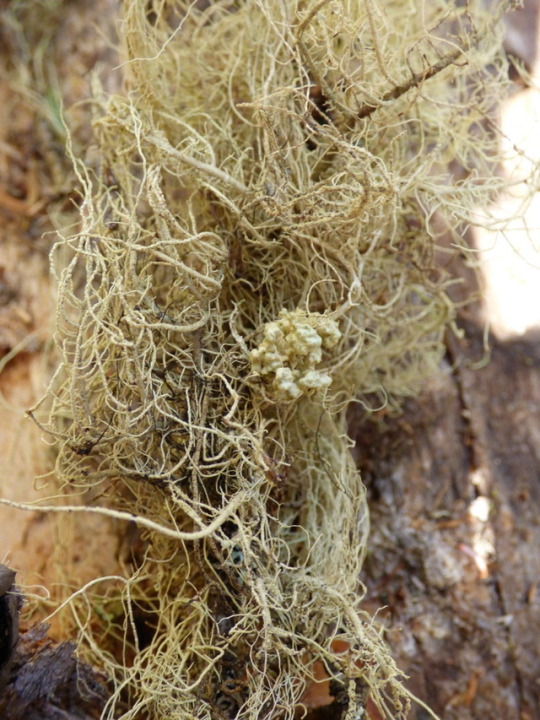
Preface
Yes, this post is long enough to require a preface.
As promised, this is the extent of the world’s knowledge on Tremella everniae, gathered from the literature and an interview with Veera Tuovinen, a grad student who does research on this species. This was originally written as an assignment for my Fungi course where I had to make a wikipedia-style page about a species, and now I’m sharing it with y’all to celebrate getting an A+ in the course AND a job working with my prof this summer!
Tremella everniae
Binomial name: Tremella everniae Deiderich
English name: none
Classification
Phylum: Basidiomycota
Class: Tremellomycetes
Order: Tremellales
Family: Tremellaceae
Genus: Tremella
Species: Tremella everniae
Description
Tremella everniae is a lichenicolous Basidiomycete fungus thought to be parasitic on the Ascomycete lichens Evernia mesomorpha, Evernia prunastri, and Evernia esorediosa. The only structure currently described is its fruiting body or basidioma, which is a popcorn-like gall formed on the host. The basidioma is 3-15mm in diameter and is initially the same grey-green colour as the host, then develops a brownish hymenium at maturity. The interior of the basidioma appears white and fluffy, and contains hyphae of both T. everniae and the host fungus, algal cells, and basidia and basidiospores of T. everniae.
Tremella everniae is a heterobasidiomycete. Heterobasidiomycetes are a polyphyletic group characterized by basidiospores which can germinate by means of secondary spores, basidia that are are often septate, and being saprophytes or parasites on other fungi or on plants. The genus Tremella is not a monophyletic group, so T. everniae has little in common with jelly fungi also included in this genus.
Life Cycle
Tremella species are generally all dimorphic, having a hyphal teleomorph and a yeast anamorph. Although only the fruiting body of the hyphal phase has been described in T. everniae, it is assumed that this species is dimorphic and has a yeast phase as well. It is hypothesized that the yeast phase may be found in the cortex of the host lichen.
There are two phases of the dimorphic life cycle, haploid yeast and dikaryotic mycelium. The yeast cells conjugate to form the mycelium, which then forms the fruiting body, which produces basidiospores that give rise to more yeast cells. The mycelium may also produce conidia which give rise to yeast cells.
Ecology and Distribution
Tremella everniae can be found on the lichen Evernia mesomorpha. It has also been found on the lichens Evernia prunastri in Europe and Evernia esorediosa in northern Asia.
The exact distribution of T. everniae is unknown but assumed to be the same as that of its host lichens. E. mesomorpha is found over conifers in open boreal forests at lower elevations. E. prunastri is found over coniferous and deciduous trees and shrubs in sheltered, humid forests at lower elevations. Both host lichens are incompletely circumpolar.
In Alberta, T. everniae can be found in the boreal forest.
Parasitism
Tremella everniae is thought to be mycoparasitic on the fungus in its host lichens. Almost all Tremella species are mycoparasites, and so it is assumed that the same is true of T. everniae. However, because the genus Tremella is polyphyletic, its species may bear little resemblance to each other. T. everniae has lots of haustoria, the structures known to be used by parasitic fungi to extract resources from their hosts, however the presence of haustoria is not necessarily evidence of mycoparasitism. It is unknown whether the haustoria of T. everniae actually penetrate the host cells. Additionally, some assume that the presence of galls is automatically an indication of disease, however this has not been proven.
Future Research
Very little is known about Tremella everniae! Future research could focus on locating the yeast phase, and determining the exact nature of the relationship between T. everniae and its host lichen. It would also be valuable to determine the phylogenetic relationships within the polyphyletic genus Tremella in order to make valid comparisons between species.
Gallery
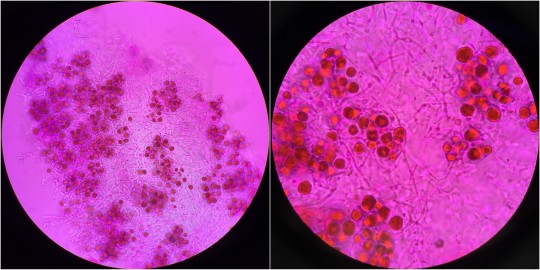
Left: Cross section of Tremella everniae fruiting body stained with phloxine and viewed at 40x magnification. Note the algal cells (large red circles) and fungal hyphae (squiggly lines). Right: Cross section of Tremella everniae fruiting body stained with phloxine and viewed at 100x magnification.
References
von Brackel, W. and D. Puntillo. 2016. New records of lichenicolous fungi from Calabria (southern Italy), including a first checklist. Herzogia 29(2):277-306.
Diederich, P. The Lichenicolous Heterobasidiomycetes. Bibliotheca Lichenologica 61.
Goward, T. 1999. The Lichens of British Columbia: Illustrated Keys, Part 2 - Fruticose Species. Crown Publications, Victoria, British Columbia, Canada.
Liu, X.-Z., Q.-M. Wang, M. Göker, M. Groenewald, A. V. Kachalkin, H. T. Lumbsch, A. M. Millanes, M. Wedin, A. M. Yurkov, T. Boekhout, and F.-Y. Bai. 2016. Towards an integrated phylogenetic classification of the Tremellomycetes. Studies in Mycology 81:85-147.
Millanes, A. M., P. Diederich, S. Ekman, and M. Wedin. 2011. Phylogeny and character evolution in the jelly fungi (Tremellomycetes, Basidiomycota, Fungi). Molecular Phylogenetics and Evolution 61:12-28.
Zhurbenko, M. P. and S. E. Vershinina. 2014. Opegrapha bryoriae sp. nov. and other lichenicolous fungi from Asian Russia. Herzogia 27(1):93-109.
Zugmaier, W., R. Bauer, and F. Oberwinkler. 1994. Mycoparasitism of some Tremella species. Mycologia 86(1):49-56.
#fungi#fungus#lichen#lichens#mycology#science#tremella#tremella everniae#evernia#evernia mesomorpha#evernia prunastri#evernia esorediosa#lichenicolous fungus#mycoparasitism#lichenology#not plants
29 notes
·
View notes
Text
Easy Electric Rat Traps
The term fancy rat refers towards the domesticated version of the brown rat. Either you can stop the rodents from entering your home, which can be an nearly impossible task, or set traps in strategically located places to head them off if they ought to be lucky enough to gain entrance. But it only takes a few people who have straightforward thinking to bring about change. It is important for you to definitely discover the root cause pest control company in lekki of the entire problem because should you fail to properly look for your source and the point of entry then it might be a challenge for one to look for a permanent solution.
However, for a lot of folks in this busy world that people live in, wanting to maintain a good diet and moderate workout program gets to be more plus more difficult. If you are the person who can spend much, you can search about the Internet and appearance for the best https://www.homedepot.com/c/termite_control performance specs. ), peanut butter is best suited since it can stay fresh for a few days and cannot be easily moved. Instinctively mice run through the walls and hide there. We proudly offer free estimates!.
Remove the tape once done using the axles. Once starter fish are introduced to a aquarium a process referred to as Nitrogen Cycle begins. It will be the partially acetylated -glucan which can be uniquely formed throughout the basidiomycetes cultivation process.

Attack Internally Finally, add garlic and brewer's yeast to your pet's diet. You can engage a quantity of those who have specialized mouse control tools which they are certified to use. Effectiveness.
In all cases studied, except for cancers of the blood, AHCC continues to be found being suitable for all cancers. They do add weight as well. Even try rubbing the yeast to your pet's fur. They are, also, more comfortable around people along with other animals than their wild counterparts. Caution: Wear a dust mask to prevent the easily inhaled, finely ground diatomaceous earth utilized in pool filters and pennyroyal and tobacco powder large quantities can be toxic to you and your pets.
Please begin today to stop supporting the heartless laboratory testing of innocent animals, the insidious cover-up and rush to promote of big business, as well as the unwitting harm we may be doing to our children, our pets, and our planet. So yes, some women will fall for and stay with bad boys. Make certain that the surface of your dwelling is free of debris (which the rats are able to use as shelter), food (seal off your garbage in containers), and water (leave your pooch's water bowl inside).
Fancy pet rats possess a decreased sensitivity to light and sound. Also vacuum your rugs every 2 to 3 days. It will be the partially acetylated -glucan which can be uniquely formed through the basidiomycetes cultivation process.
Fancy rats could make great pets for adults, children, and families. The results of this intense work triggered a change of career for Paul Bach-y-Rita, who then dedicated to rehabilitation medicine (especially with "late rehabilitation" stoke patients), using the techniques he know knew had validity. The results of this intense work triggered a career change for Paul Bach-y-Rita, who then centered on rehabilitation medicine (especially with "late rehabilitation" stoke patients), using the techniques he know knew had validity. With proper rat repellent methods, you can rid your property from rats once and then for all.
5 notes
·
View notes
Text
The Future According to Mota Edibles Experts
The life cycle of the upper fungus (macrofungi)
The life cycle of basidiomycetes includes specific stages such as genetic mutation [3]. Spores from basidium are usually produced for sexual reproduction, rather than for asexual reproduction [20]. The club-shaped basidium carries a substance called basidiospores.
In the basidium, the nuclei of two different types of mating (- and +) and fuse (karyogamy), which causes the diploid zygote and then meiosis as shown in Figure 1. The haploid nuclei migrate to the basidiospores, bursting and produce monokaryotic hyphae. The extracellular mycelium is called the primary mycelium. Mycelia of different mating species can combine and produce a second mycelium containing haploid nuclei of two different mating species.
This is the decayotic phase of the basidiomycetes lifecycle, also called the dominant phase. Finally, the second mycelium produces basidiocarp, a fruit-bearing organ that extends beyond the soil (epigeous macrofungi) as the basidiocarp carries a growing bactericidal bone under its cap at a depth of 10-20 cm or below the ground as hypogeous macrofungi. or truffles. In the phylum mota edibles, sexual reproduction is usually directed by two sets of independent mating genes, which control the stages of the sexual cycle.
Genetics include pre-lipopeptide pheromones and their cognate receptors that mediate mating partner recognition, cell synthesis, and homeodomain transcription factors, forming heterodimers to regulate mating behavior. Sexual reproduction in a wide variety of fungi plays an important role in pathogenic development, promoting genetic diversity, adaptability, and longevity [21].
Examples of other wild and medicinal mushrooms
Types of Ganoderma
Polypore mushroom, which grows on wood. Ganoderma can be separated from other polypores because it has a double-walled basidiospore. The name Ganoderma is derived from the Greek ganos "brightness-sheen" or "shining" and the derma "skin" [22]. Ganoderma is characterized by large, endless, and woody basidiocarps, also called "cones." They are lignicolous, with or without skin. Fruit bodies usually grow in the form of a fan or hoof on the trunks of living or dead trees. It has double walls, abbreviated characters with decorated yellow to brown interior layers. This type was invented by Karsten in 1881. Members of the Ganodermataceae family were traditionally considered to be difficult to distinguish due to a lack of reliable morphological features, the species being divided into two groups: Ganoderma with a shiny cap surface like G. lucidum and Elfvingia with a mota edibles cap like G. aapplanatum [23]. Phylogenetic analysis using DNA sequencing information obtained from mitochondrial Small Subunit (SSU) rDNA has helped clarify our understanding of the relationships between Ganoderma species. The genus can now be divided into a specific monophyletic group, G. colossus, G. applanatum, G. tsugae, Asian group G. lucidum, G. meredithiae, and G. resinaceum [24].
Types of Rigidoporus
The mold forms a mass of white mycelia, which is said to be a thin strip of 1-2 mm thick that grows and attaches firmly to the surface of the root bark. Rigidoporus microporus is a broad fruit body (20 cm wide), leathery, slightly velvety, shelf attached to a wide, and usually imbricate and substrate. Their color ranged from orange to red or brown and later faded [25]. These rhizomorphs grow rapidly and can extend several meters into the soil when there is no woody substrate. Therefore, healthy rubber trees can be infested with free rhizomorphs growing on stems or infected debris buried in the ground and roots that affect those of a neighboring sick tree [26].
Types of Tremella
Tremella spp. belongs to the family Tremellaceae. Tremella spp. parasites of other fungi and most produce anamorphic yeast states where Basidiocarps (fruit bodies) are produced; they are gelatinous and are grouped separately between “jelly fungi.” More than 100 types of Tremella are known worldwide at present. There are two types namely: T. fuciformis and T. aurantialba are grown for food for consumption [27]. The word comes from the Latin tremere meaning "trembling." Linnaeus placed Tremella on a mixture that included seaweed, cyanobacteria, and myxomycetes as well as fungi, but Persoon reviewed Tremella in 1794 and 1801. He re-created and regarded Tremella as a genus (Tremella Pers.) From the beginning created by Linnaeus (Tremella L.).
Tremella Pers. is now preserved under the International Code for Plant Nomenclature and Tremella mesenterica as a plant species [28]. Tremella varieties produce hyphae that are usually (but not always) bound and have haustorial cells, which enter the host hyphae. Basids are “tremelloid,” ranging from globose to ellipsoid in direct or diagonal separation. Conidiophores are usually present and resemble yeast cells [28]. Tremella mesenterica occurs mainly in broad, mixed leaf forests. It is widely distributed in tropical and subtropical regions, including Africa, Asia, Australia, Europe, and North and South America. Although considered mota edibles and tasteless, the fungus is edible. Tremella mesenterica produces bioactive compounds that attract research interest due to their diverse biological functions [29].
Types of Agaricus
It is an important species of mushroom that contains both edible and toxic species with over 300 members worldwide. The genus includes the common mushroom (button) (Agaricus bisporus) and wild mushroom (Agaricus campestris). Agaricus members are characterized by a fleshy cap (pileus) that emerges from the lower abscesses producing nudity [30]. Agaricus members also have a stem (stipe), which lifts the mass over the substrate and partially veins and protects the growing bones a.
0 notes
Photo
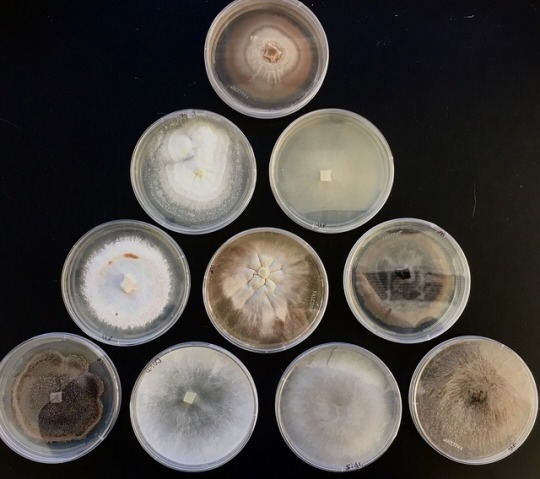
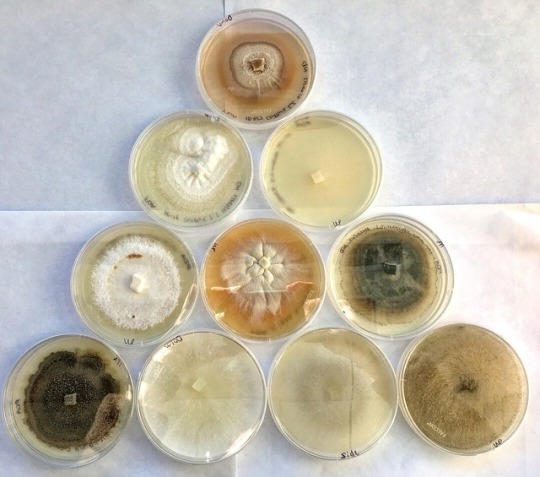
The Kingdom Fungi is one of the most diverse groups on Earth, second only to insects. Due to their cryptic nature - living underground/inside other things, only showing up to reproduce and then having small bodies, not easily leaving behind fossils - understanding fungal diversity and the relatedness between species is still an ongoing process. • These species pictured all decompose for a living, but they’re not closely related at all! They are 10 species from 3 phyla: Basidiomycetes (mushroom formers), Ascomycetes (some mushrooms, lots of molds and yeasts), and Zygomycetes (also named Mucoromycetes, names are constantly changing). • Also how cool is it to see the colors change depending on the background?!
2 notes
·
View notes
Text
Postdoc: UHawaii.FungalGenomics
Postdoc in marine fungal genomics, University of Hawaii A postdoc position is available in the Amend Lab in the Department of Botany at the University of Hawaii at Manoa. The successful applicant will join a dynamic group of researchers interested in microbial ecology and evolution within the unique Hawaiian archipelago. The researcher will primarily be responsible for genome sequencing and analysis of marine yeasts from the genus Malassezia. This genus of Basidiomycete yeasts, recently placed within its own class, is ecologically hyperdiverse and among the most widespread and numerically dominant fungi in the worlds oceans: found in deep-sea sediments, hydrothermal vents, on and in invertebrate hosts and throughout pelagic water columns. Improbably, Malassezia also dominate mammal skin on land, are prevalent residents of terrestrial animal guts, and are consistent, though low abundance, members of soil and plant fungal communities. There exist excellent genomic resources for this group, and all but one of the fifteen species for which genomes are sequenced contains fewer than 9 Mb and 5,000 genes, placing them amongst the smallest free-living genomes in kingdom fungi. Malassezia are also dikaryotic (N+N), with a genomic signature of bipolar mating types. This and evidence that Malassezia genomes have undergone extensive rearrangements and gene loss/gain events suggests the potential for rapid evolution. Our main interest is to identify the mechanisms enabling transitions from terrestrial to marine habitats, and to infer how frequently such transitions have occurred. Because none of the marine species have been cultivated yet, the postdoc will be responsible for developing and implementing a single cell genomic workflow targeting habitats in which Malassezia are known to dominate. The researcher will have access to two marine stations, sequencing, microscopy and flow cytometry core facilities as well as access to a large campus supercomputer. The appointment is for one year. Salary is commensurate with experience, and will be livable given Hawaii's high cost of living. Start date is as soon as is feasible. The Amend lab is strongly committed to achieving excellence through diversity. We are aware of biases, conscious and unconscious, in academia and in science and we actively seek to reduce the role of these biases in our own decisions and in those of our colleagues and collaborators. We work together to combat prejudice and work toward equity and inclusion, within the lab and in the communities with whom we interact V on campus and beyond. Required Qualifications Successful candidates will hold a Ph.D. degree in biology, marine biology, microbiology, genetics or another relevant field. Researchers must be willing to contribute to a respectful, collegial, honest, and productive lab environment. Desirable Qualifications -Experience designing clade specific probes/primers -Experience using fluorescence activated cell sorting or other flow cytometry capture techniques -Experience assembling and annotating genomic data -Experience analyzing genomes within a comparative context -Creativity -Evidence of compelling and clear scientific writing. To apply Please visit our labs website to learn more about the group and the research we conduct: http://bit.ly/2SEDFba. A short review paper on marine Malassezia is available here: http://bit.ly/2QEtp5p As a single PDF, please submit a CV, a cover letter, and the names/contact information for three referees to Anthony Amend: [email protected]. Consideration of applications will begin immediately and will continue until the position is filled. Anthony Amend
via Gmail
0 notes
Text
Genes, Vol. 9, Pages 118: Genome-Wide Identification of circ#RNAs in Pathogenic Basidiomycetous Yeast Cryptococcus neoformans Suggests Conserved circ#RNA Host Genes over Kingdoms
Circular #RNAs (circ#RNAs), a novel class of ubiquitous and intriguing noncoding #RNA, have been found in a number of eukaryotes but not yet basidiomycetes. In this study, we identified 73 circ#RNAs from 39.28 million filtered #RNA reads from the basidiomycete Cryptococcus neoformans JEC21 using next-generation sequencing (NGS) and the bioinformatics tool circular #RNA identification (CIRI). Furthermore, mapping of newly found circ#RNAs to the genome showed that 73.97% of the circ#RNAs originated from exonic regions, whereas 20.55% were from intergenic regions and 5.48% were from intronic regions. Enrichment analysis of circ#RNA host genes was conducted based on the Gene Ontology and Kyoto Encyclopedia of Genes and Genomes pathway databases. The results reveal that host genes are mainly responsible for primary metabolism and, interestingly, ribosomal protein production. Furthermore, we uncovered a high-level circ#RNA that was a transcript from the guanosine triphosphate (GTP)ase gene CNM01190 (gene ID: 3255052) in our yeast. Coincidentally, YPT5, CNM01190′s ortholog of the GTPase in Schizosaccharomyces pombe, protists, and humans, has already been proven to generate circ#RNAs. Additionally, overexpression of #RNA debranching enzyme DBR1 had varied influence on the expression of circ#RNAs, indicating that multiple circ#RNA biosynthesis pathways exist in C. neoformans. Our study provides evidence for the existence of stable circ#RNAs in the opportunistic human pathogen C. neoformans and raises a question regarding their role related to pathogenesis in this yeast. http://bit.ly/2ooi9e4 #MDPI
0 notes
Quote
"Yeast, as I’ve discussed here before, is a way of life, not a taxonomic group. Yeast are fungi growing as single cells rather than as chains of cells in fuzzy filaments. Standard baker’s and brewer’s yeast are Saccharomyces cerevisiae, an ascomycete fungus. The fungi that form most lichens are also ascomycetes – but filamentous forms. But basidiomycetes can live as yeast as well, and this seems to be the case here." via Instapaper http://ift.tt/2jlSoaM
https://blogs.scientificamerican.com/artful-amoeba/2-lichen-mysteries-solved-reveal-a-greater-hidden-truth/
0 notes
Text
Genome-wide and enzymatic analysis reveals efficient D-galacturonic acid metabolism in the basidiomycete yeast Rhodosporidium toruloides
BioRxiv: http://dlvr.it/R72XgF
0 notes